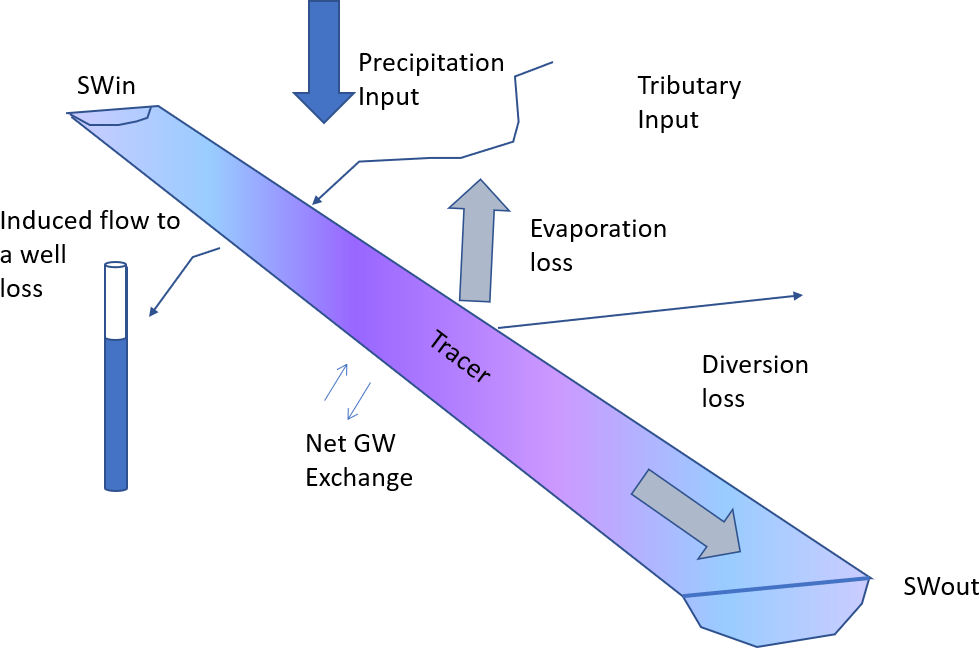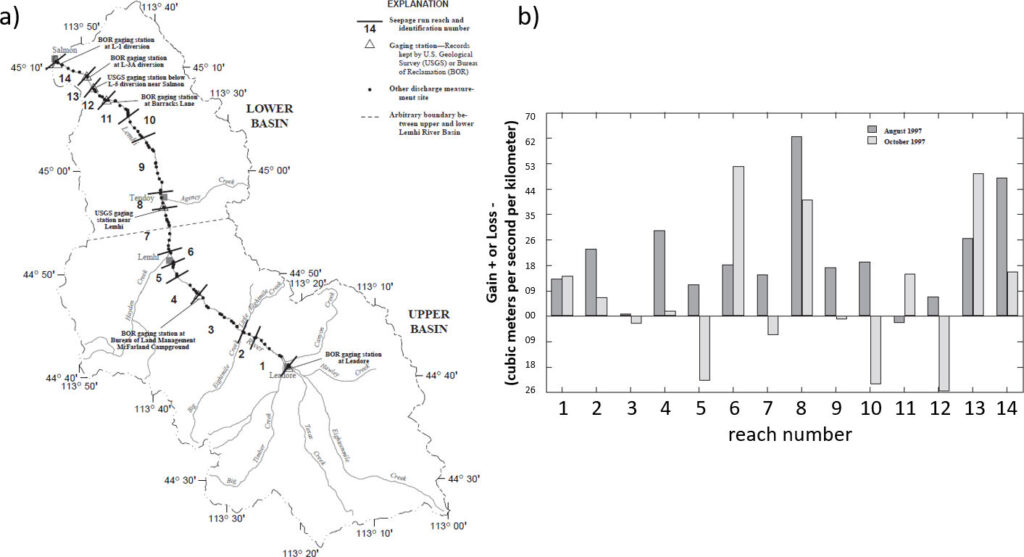5.4 Stream Synoptic Surveys
Synoptic surveys or seepage runs are used to assess exchange conditions in streams. They are conducted by measuring stream discharges at two or more locations and taking the difference between the measurements to determine if discharge is increasing or decreasing, that is whether the stream is gaining or losing. This method is based on physical streamflow gauging and requires consideration of the entire water budget between survey boundaries (Figure 56). Seepage runs are typically conducted over a short time period during which flow conditions are assumed to be in a steady state. Net groundwater inflow is computed from the difference between inputs and outputs as shown in Equation 2.

|
(SWout + other channel losses) − (SWin + Inputs) = Net GW Exchange
|
(2) |
where:
| SWout | = | discharge of the reach measured at the downstream location (L3/T) |
| other channel losses | = | quantified or estimated (e.g. diversions, evaporation, infiltration and capture of river water at a nearby shallow pumping well) (L3/T) |
| SWin | = | discharge of the stream measured at the upstream monitoring point (L3/T) |
| Inputs | = | quantified or estimated gains of surface water between the upstream and downstream monitoring locations (e.g. precipitation and inflow from tributaries) (L3/T) |
| Net GW Exchange | = | additional gain or loss of stream discharge attributed to groundwater (L3/T) |
Synoptic surveys, though useful, must be carefully planned as measurement errors can be large. Ideally, when discharge at the upstream location is subtracted from discharge at the downstream location and value is positive, the reach is effluent, gaining groundwater; while when negative, the channel is losing water to the underlying groundwater system (some reporting methods may reverse the sign of the net difference). It is important that seepage runs are designed so that measurement errors and uncertainties do not mask the computed net gains or losses.
Donato (1998) conducted two seepage runs (synoptic surveys) on the Lemhi River, Idaho, USA. A section of channel approximately 100 km in length was subdivided into 14 reaches (Figure 57). Current meter gauging methods were used to determine stream discharge (assuming a 5% measurement error). Measurements included diversions and tributaries within reaches and were completed at 117 sites over a five-day period. The first seepage run was conducted in August (under high groundwater elevations during the irrigation season) and the second in October 1997 (after irrigation ceased). Results of seepage gains and losses for each seepage run showed the river was effluent during August at most all reaches (Figure 57). During the October run, at least six reaches changed from gaining to losing. For the 28 computed gains or losses only 5 were deemed compromised by measurement error overlap (5%). In this study, a large number of measurements were required to characterize the system because the river was influenced by intensive irrigation. The study also illustrates the transient nature of exchange.

Individual instruments and methods need to be researched to define likely ranges of measurement errors. The reach length selected for a synoptic survey needs to be sufficiently long so that discharge measurement differences are larger than the error envelope for each measurement as discussed in Box 4. Conducting seepage runs in lower order streams (smaller flows) is less complicated than using the techniques to characterize higher order streams (large flows). Generally, larger streamflow is more difficult to measure (thus typically have larger error) and longer reaches are needed to quantify changes. It should also be noted that methods yield net exchange, but multiple exchange processes may occur within a reach as explained in Section 2 of this book.
In regions with seasonal variation, seepage runs are often planned for a time when transpiration by streamside vegetation is small (e.g., after a killing frost) to simplify the reach water budget. However, usually surveys are repeated during other seasons to characterize how seasonal factors influence exchange.
